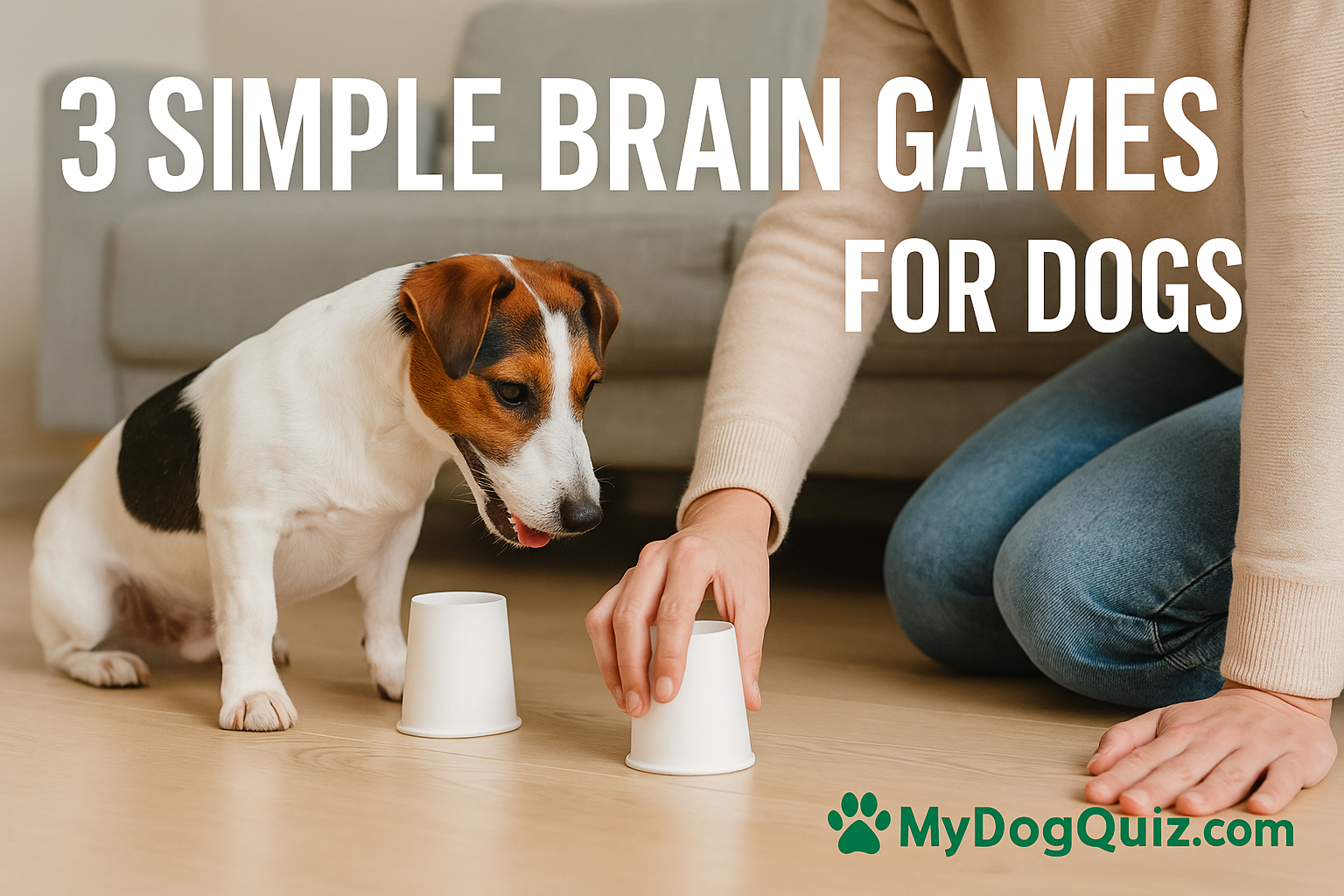If your dog acts stubborn — ignoring commands, losing focus, or tuning you out — it’s not because they’re bad. It’s because their brain is bored.
Most owners focus on physical exercise: walks, fetch, or tug-of-war. Those help, but they don’t teach your dog how to think.
And when your dog’s mind isn’t challenged, their behavior can spiral into disobedience, barking, or endless energy bursts.
That’s where brain games come in.
Just 10 minutes a day of the right mental stimulation can transform your dog’s attitude and focus.
No yelling. No punishment. Just smart play.
👉 Take the 30-Second Dog Brain Quiz to discover your dog’s learning type before you start.
1. The “Find It” Game — Unlocking Focus and Patience
Dogs have up to 300 million scent receptors — that’s over 40 times more than humans. When you tap into their natural sniffing instincts, their brain lights up like fireworks.
The “Find It” game teaches your dog focus, impulse control, and confidence — all while having fun.
🧠 How to Play:
- Take 3–5 treats and show them to your dog.
- Ask your dog to “stay” (or gently hold them back).
- Hide the treats around the room — under cushions, behind furniture, under a cup, etc.
- Say “Find it!” and let them search.
- Celebrate when they find each treat.
At first, make it easy. Then gradually make it harder — different rooms, trickier hiding spots, longer wait times before release.
This game teaches your dog to stay calm and think, not react. Over time, it rewires the brain to process commands faster — perfect for “stubborn” learners.
👉 Pro Tip: Dogs that ace “Find It” are usually Thinkers. You can confirm your dog’s learning type by taking the 30-Second Dog Brain Quiz.
2. The “Cup Game” — Building Problem-Solving and Memory
This one’s simple but powerful.
It teaches patience, observation, and working memory — the part of your dog’s brain that helps them remember patterns and anticipate results.
🧠 How to Play:
- Grab 3 plastic cups and one small treat.
- Let your dog watch you place the treat under one cup.
- Shuffle the cups slowly.
- Ask your dog to “find it.”
- When they pick the correct cup, lift it and reward them.
Start easy. Then increase difficulty by shuffling faster or using four cups instead of three.
You’ll notice your dog begins using their nose and eyes to track the reward — this mental multitasking strengthens the brain’s neural pathways just like human memory games do.
Over time, this builds focus under pressure, which helps your dog listen better in real-life distractions — walks, guests, or other dogs.
👉 Science says: Dogs who engage in problem-solving games show measurable improvement in obedience and emotional balance within two weeks.
3. The “Name That Toy” Challenge — Supercharging Obedience
This one feels almost magical when it clicks.
Dogs can actually learn the names of objects — not just commands.
One famous border collie named Chaser learned over 1,000 toy names. That’s not unique to her — your dog can do it too with the right game.
🧠 How to Play:
- Pick two of your dog’s favorite toys — say a ball and a rope.
- Hold one up and say its name several times: “Ball, ball, ball.” Then throw it and say “Get the ball!”
- Repeat until your dog retrieves it on cue.
- Next, do the same with the rope.
- Once they know both, place both toys on the floor and ask for one by name.
When your dog picks correctly — praise like crazy!
This exercise activates language association in your dog’s left hemisphere — the same part of their brain humans use for vocabulary.
After a week or two, most dogs can confidently fetch by name. Add more toys slowly to keep it challenging and fun.
This isn’t just a game — it’s obedience training disguised as play.
👉 Want to know if your dog’s a “Word Learner” or a “Pattern Solver”?
Find out in the Dog Brain Quiz and get training ideas matched to their brain style.
4. Why Brain Games Work So Fast
Each of these activities taps into dopamine-based learning — a natural chemical process that rewards focus and curiosity.
When your dog’s brain releases dopamine during a game, they feel happy and motivated. That “happy focus” makes training feel like a game, not a chore.
Instead of you forcing obedience, your dog chooses to participate — and learns faster as a result.
That’s why brain training has become the go-to method for certified trainers like Adrienne Farricelli, creator of Brain Training for Dogs.
Her approach blends neuroscience, behavioral psychology, and positive reinforcement — giving you tools that actually work.
It’s not magic. It’s science — and it’s fun for both of you.
5. The 10-Minute Transformation Routine
Want to make brain games a habit? Here’s a simple daily schedule you can follow:
| Time | Activity | Focus |
|---|---|---|
| Morning | “Find It” game | Sniffing & patience |
| Afternoon | “Cup Game” | Problem-solving & focus |
| Evening | “Name That Toy” | Vocabulary & obedience |
Each session should last 5–10 minutes max.
The key isn’t length — it’s consistency.
Dogs learn through short, repeated bursts of engagement. Within days, you’ll start noticing:
- Faster responses to commands
- Fewer distractions during walks
- More calm energy at home
That’s what happens when your dog’s brain starts firing in “learning mode” instead of “chaos mode.”
6. The Science Behind Brain Training
Recent studies show that mental stimulation reduces stress hormones in dogs and improves emotional control.
Dogs trained through cognitive games show:
- Lower cortisol (stress) levels
- More predictable focus
- Better adaptability to new environments
In other words, the more you train their brain, the easier it becomes to train anything else.
And because brain games build trust through shared success, your bond with your dog deepens naturally.
That’s why so many trainers now say:
“The best way to fix behavior isn’t correction — it’s connection.”
7. Ready to Turn Stubborn Into Smart?
If you’ve been calling your dog “stubborn,” try calling them bored instead.
Because once you start engaging their brain the right way, everything changes.
They start listening.
They focus longer.
They learn faster — and actually enjoy it.
And it doesn’t take hours of training — just a few minutes of brain play every day.
👉 Take the 30-Second Dog Brain Quiz
Find out your dog’s learning personality and get personalized brain game recommendations based on how their mind works.
Because when you train your dog’s brain, obedience becomes natural — and stubbornness disappears.
🔹 Meta Details
SEO Title (≤60 chars):
Meta Description (≤160 chars):
Facebook/X Title:
Facebook/X Description: These easy brain games can calm, focus, and train your dog faster than yelling ever could. Take the 30-second Dog Brain Quiz to start.
Image Alt Text: Dog playing a brain game with owner using cups and treats indoors.
Image Size: 1280×776
Caption: Brain games make obedience fun and natural for dogs of all ages.


Leave a Reply